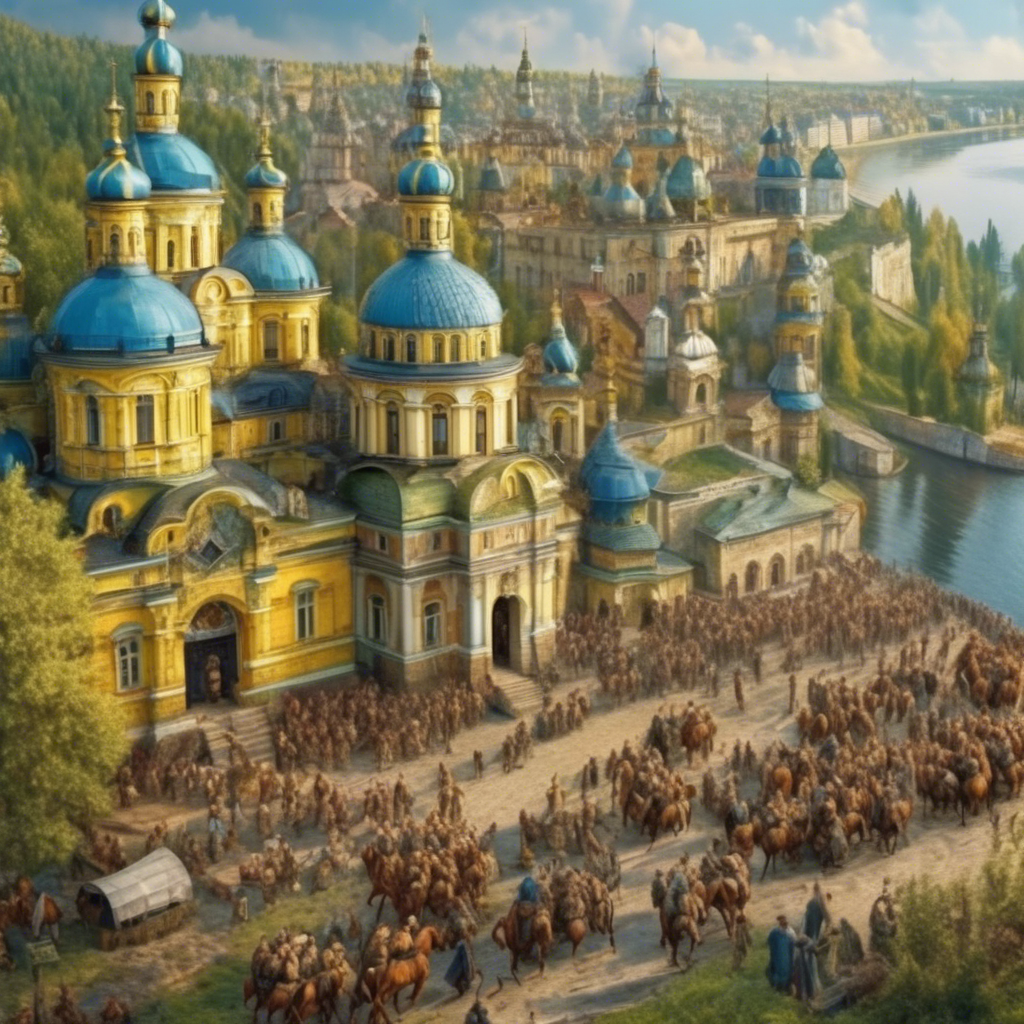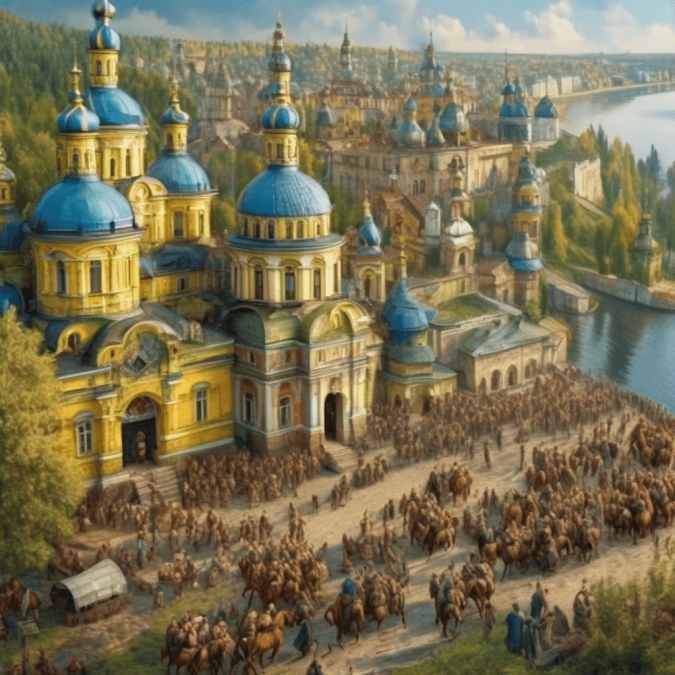
1. Introduction
The project on the history of Ukraine aims to provide a comprehensive overview of the rich and diverse historical narrative of the country. Understanding the history of Ukraine is crucial for appreciating the cultural, political, and social dynamics that have shaped the nation over centuries. The project’s objectives include exploring the geographical location of Ukraine, examining the early settlements and civilizations that influenced its development, and highlighting key historical events that have defined Ukraine’s identity.
2. Historical Background
Ukraine, situated in Eastern Europe, has a strategic geographical location that has attracted various civilizations throughout history. Prehistoric settlements in Ukraine date back to ancient times, showcasing the region’s early human habitation. The influence of neighboring civilizations such as the Greeks, Romans, and Mongols has left a lasting impact on Ukraine’s cultural and architectural heritage.
Geographical location of Ukraine
Ukraine is located in Eastern Europe, bordered by Russia to the east, Belarus to the north, Poland, Slovakia, and Hungary to the west, and Romania and Moldova to the south. Its diverse landscape includes plains, plateaus, and the Carpathian Mountains.
Prehistoric settlements in Ukraine
Archaeological evidence indicates that Ukraine was inhabited by early humans as far back as the Paleolithic era. The Trypillian culture, known for its advanced agricultural practices and large settlements, thrived in what is now Ukraine around 5400-2700 BC.
Influence of neighboring civilizations (e.g. Greeks, Romans, Mongols)
Throughout its history, Ukraine has been influenced by neighboring civilizations. The Greeks established colonies on the Black Sea coast, contributing to trade and cultural exchange. The Romans left traces of their presence in Ukraine, particularly in the ancient city of Olbia. The Mongol invasion in the 13th century left a lasting impact on Ukrainian territories, leading to political fragmentation and social upheaval.
3. Early History
The formation of ancient Ukrainian states, notably the powerful Kievan Rus, marked a significant period in Ukraine’s early history. The Christianization of Kievan Rus under Prince Vladimir the Great established Orthodox Christianity as a dominant religion in the region. However, the Mongol invasion in the 13th century led to the decline of Kievan Rus.
Formation of ancient Ukrainian states (e.g. Kievan Rus)
Kievan Rus, established in the 9th century by the Varangians, was a powerful medieval state that encompassed parts of modern-day Ukraine, Russia, and Belarus. The city of Kiev served as the capital and cultural center of Kievan Rus, fostering trade and intellectual exchange.
Christianization of Kievan Rus
In 988, Prince Vladimir the Great of Kievan Rus adopted Orthodox Christianity as the state religion, leading to the spread of Christianity among the population. The conversion reshaped the religious and cultural landscape of the region, connecting Kievan Rus to the Byzantine Empire.
Mongol invasion and the decline of Kievan Rus
The Mongol invasion of Kievan Rus in 1240, led by Batu Khan, resulted in the destruction of Kiev and the fragmentation of the state. The Mongol rule over Ukraine, known as the Golden Horde, brought economic hardship and political instability to the region, contributing to the decline of Kievan Rus.
4. Cossack Era
The Cossack era in Ukraine was characterized by the rise of the Cossacks as a distinct social and military group. The Hetmanate period saw the establishment of Cossack-run territories known as Hetmanates, with elected Hetmans leading the Cossack armies. Cossack uprisings and conflicts with neighboring powers, including Poland and Russia, marked this turbulent period in Ukrainian history.
Rise of the Cossacks
The Cossacks emerged as a semi-military community in the 15th century, known for their military prowess and independent spirit. They played a significant role in defending Ukrainian territories and resisting foreign invasions.
Hetmanate period
The Hetmanate period, starting in the mid-17th century, was characterized by the consolidation of Cossack power in Ukraine. Hetmans, elected leaders of the Cossack armies, governed semi-autonomous regions known as Hetmanates, fostering a sense of unity among the Cossack community.
Cossack uprisings and conflicts with neighboring powers
The Cossacks rebelled against Polish and Russian rule, seeking to maintain their autonomy and defend Ukrainian territories. Uprisings such as the Khmelnytsky Uprising in the mid-17th century and the Koliyivshchyna movement in the 18th century reflected the Cossacks’ resistance to external control.
5. Imperial Rule
The annexation of Ukraine by the Russian Empire in the late 18th century marked a significant turning point in Ukrainian history. Ukrainian cultural and political movements in the 19th century, such as the Ukrainian national revival, sought to preserve Ukrainian identity and language. However, the 20th century brought famine and repression under Soviet rule, leading to immense suffering and loss for the Ukrainian people.
Annexation of Ukraine by the Russian Empire
The partitions of Poland in the late 18th century resulted in the incorporation of Ukrainian territories into the Russian Empire. The policies of Russification and suppression of Ukrainian culture by the Russian authorities fueled nationalist sentiments among Ukrainians.
Ukrainian cultural and political movements in the 19th century
The 19th century witnessed a revival of Ukrainian national consciousness, with intellectuals and activists advocating for the preservation of Ukrainian language and culture. Taras Shevchenko, a prominent Ukrainian poet and artist, played a key role in promoting Ukrainian identity.
Famine and repression under Soviet rule
The Soviet regime under Joseph Stalin imposed collectivization and forced industrialization policies in Ukraine, leading to the man-made famine known as the Holodomor. The repressive measures of the Soviet government, including purges and political repression, resulted in widespread suffering and loss of life among the Ukrainian population.
6. Independence and Modern History
The declaration of independence by Ukraine in 1991 marked a new chapter in the country’s history, as it emerged from the collapse of the Soviet Union as an independent state. However, Ukraine faced numerous challenges in the transition to independence, including economic instability, political corruption, and territorial conflicts. Recent political developments and relations with neighboring countries have shaped Ukraine’s modern history and its aspirations for a democratic and prosperous future.
Declaration of Independence in 1991
Following the dissolution of the Soviet Union, Ukraine declared its independence on August 24, 1991, affirming its sovereignty and self-determination. The independence movement, led by figures such as Leonid Kravchuk and Vyacheslav Chornovil, symbolized the aspirations of the Ukrainian people for freedom and democracy.
Challenges faced by independent Ukraine
The transition to independence brought economic challenges, as Ukraine struggled to adapt to a market economy and address widespread corruption. Political instability, territorial disputes, and tensions with Russia have also posed significant obstacles to Ukraine’s development.
Recent political developments and relations with neighboring countries
Ukraine has witnessed political upheavals, including the Orange Revolution in 2004 and the Euromaidan protests in 2013-2014, which led to changes in government and a shift towards European integration. Relations with neighboring countries, particularly Russia, have been strained due to conflicts in Crimea and eastern Ukraine, shaping Ukraine’s foreign policy and security concerns.
7. Cultural Heritage
Ukraine’s cultural heritage is rich and diverse, encompassing a vibrant tradition of language, literature, folk traditions, and UNESCO World Heritage Sites. The Ukrainian language, with its unique phonetics and grammar, has played a central role in shaping national identity. Folk traditions and customs, including music, dance, and traditional crafts, reflect the cultural diversity and creativity of the Ukrainian people. UNESCO World Heritage Sites in Ukraine, such as the ancient city of Lviv and the wooden churches of the Carpathian region, highlight the country’s architectural and historical significance.
Ukrainian language and literature
The Ukrainian language, with its roots in the East Slavic linguistic tradition, has a rich literary heritage that includes works of poetry, prose, and drama. Writers such as Taras Shevchenko, Lesya Ukrainka, and Ivan Franko have made significant contributions to Ukrainian literature, promoting the language and cultural identity.
Folk traditions and customs
Ukrainian folk traditions, passed down through generations, encompass a wide range of customs, rituals, and celebrations. Traditional music, dance, and embroidery are integral parts of Ukrainian culture, reflecting regional variations and historical influences.
UNESCO World Heritage Sites in Ukraine
Ukraine is home to several UNESCO World Heritage Sites that showcase the country’s historical and architectural treasures. The ancient city of Lviv, with its well-preserved medieval architecture, and the wooden churches of the Carpathian region, exemplify Ukraine’s cultural and religious heritage recognized by UNESCO.
8. Conclusion
In conclusion, the project on the history of Ukraine has provided a detailed exploration of the country’s past, from its early settlements and ancient states to its struggles for independence and cultural heritage. The significance of studying Ukraine’s history lies in understanding the complexities of its identity, the resilience of its people, and the challenges faced in the pursuit of freedom and self-determination. Further research into Ukraine’s history can shed light on its path towards a democratic and prosperous future.
9. References
– Plokhy, Serhii. “The Gates of Europe: A History of Ukraine.” Basic Books, 2015.
– Subtelny, Orest. “Ukraine: A History.” University of Toronto Press, 2000.
– Wilson, Andrew. “The Ukrainians: Unexpected Nation.” Yale University Press, 2000.
